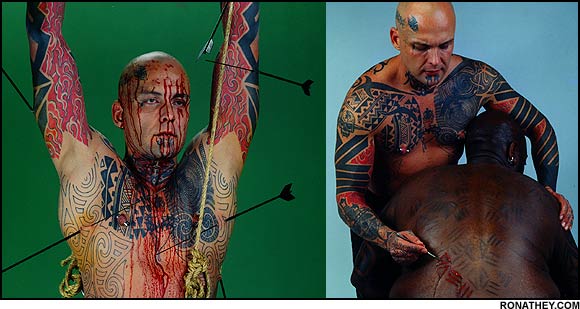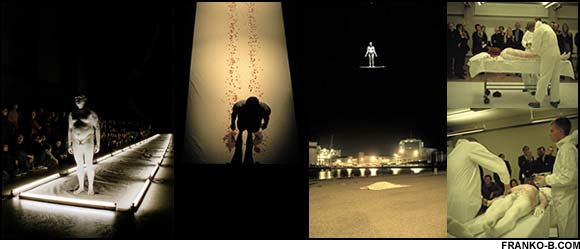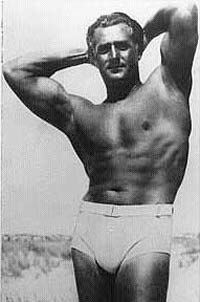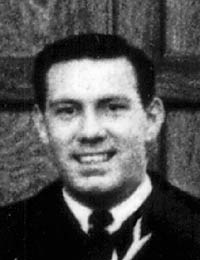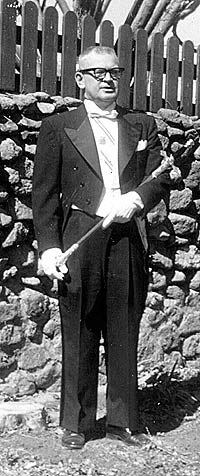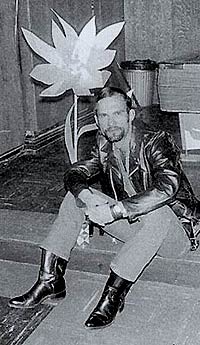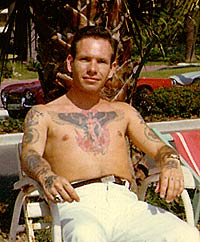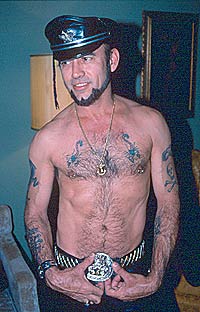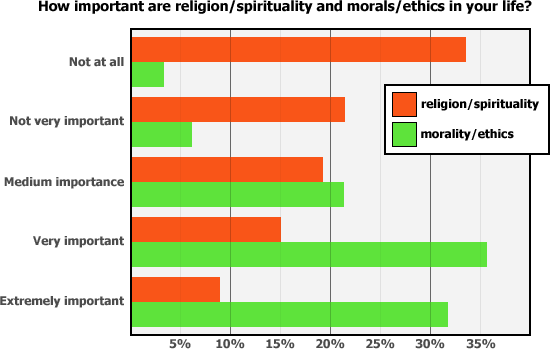 Lucifire
Lucifire
Queen of “Grotesque Burlesque”
by Danielle Clark
|
"Creative work is play. It is free speculation using materials of one's chosen form."
– Stephen Nachmanovitch
Sideshows play an important part in body modification culture. They not only give the “common folk” a way to interact with the modified in a positive manner but they also allow people to expand their definition of what a person is and how humans should be able to act. However, they seem to be dominated by males: Tim Cridland (The Torture King), Eric Sprague (The Lizardman), Paul Lawrence (The Enigma), Joseph Hermann (Mr. Lifto), and so on. Today we introduce to you someone you likely haven’t heard of before; a multi-talented sideshow performer, a singer, a fire breathing, scissor masturbating, blood letting, crotch grinding and incredibly captivating female performer — Lucifire.
Working primarily out of the UK, Luci has taken the sideshow world by storm. She offers a fresh look into the darkly entertaining modified stage performer all wrapped up in a stunning package. She offers what can only be described as “Grotesque Burlesque” — a show guaranteed to tantalize.
Danielle/BME: Can you give a little background on you, where you grew up, and your family life?
 Lucifire: I grew up in the middle of Scotland, out in the sticks. We moved around a fair bit when I was a kid, we lived in Dundee, then in an artist’s commune in a fishing village on the west coast of Scotland, then a few other places before settling in Carron Valley. It was seven miles to the nearest bus stop and my next-door neighbour on one side was a half a mile away. I guess I had too much time to myself. I didn’t mix much with kids my own age because there weren’t many around. I spent a lot of time in the company of adults and animals. My parents were both very artistic and well educated and encouraged me to be creative and freethinking. I was always the quiet one at the back of the class with my nose buried in a book, a shy retiring wallflower that drew weird pictures and wrote strange stories.
Lucifire: I grew up in the middle of Scotland, out in the sticks. We moved around a fair bit when I was a kid, we lived in Dundee, then in an artist’s commune in a fishing village on the west coast of Scotland, then a few other places before settling in Carron Valley. It was seven miles to the nearest bus stop and my next-door neighbour on one side was a half a mile away. I guess I had too much time to myself. I didn’t mix much with kids my own age because there weren’t many around. I spent a lot of time in the company of adults and animals. My parents were both very artistic and well educated and encouraged me to be creative and freethinking. I was always the quiet one at the back of the class with my nose buried in a book, a shy retiring wallflower that drew weird pictures and wrote strange stories.
My parents split up when I was five but I’ve always stayed in touch with my dad. I absolutely adore him and respect him as an artist and a human being. I don’t know anyone else with as much integrity. He lives in the Caribbean now with his girlfriend of fifteen years and I love going to see them. He plays music there and helps locals to record their own music.
My mum remarried and her new husband was wonderful too. He treated my half sister (his daughter) and me totally equally and fairly, with a lot of love. I think he wished he had a son though; he bought me my first motorbike when I was twelve and never treated me as a girl. I spent a lot of happy times with him in the garage. Nowadays I spend a lot of happy times with him in the pub.
I see a lot of my sister and although my mum and I don’t see much of each other we get on well. All of my family is very proud of me and support me in what I do.
Danielle/BME: You had an interesting childhood, very open and with great creative influences in your parents and stepparent — in what ways did they help to influence and encourage you to the way you are today and the career path you ultimately chose?
Lucifire: My dad was a community artist, setting up music and arts projects for kids, pensioners, the unemployed and anyone else that was interested. I’ve always been so amazed how my dad seems to know how to build anything. He has a wonderful combination of artistic and mathematical abilities. He bought me a keyboard and a computer when I was very young and taught me a lot about art and science and how they can combine. He showed me how to do graphics on a computer when I was a kid in the early eighties; as well as showing me how to build sculptures and taking me on his band’s gigs. I clearly remember being at gigs and hiding under the piano while he played and dodging his feet as he stomped, keeping time. When I first learned to breathe fire I told him proudly but he said, “Yeah, I used to do that but I can’t anymore because of my beard”. What an anticlimax, I thought he was going to be shocked or amazed. He’s a real big kid at heart. My dad and I both had Mohican haircuts at the same time, and I shaved my head for the first time around at his house with his clippers.
My mother was a photographer that used to dress me up in silly outfits and take pictures. She helped me make lots of amazing fancy dress costumes. Also, because we lived in isolation she would stay up until the middle of the night talking to me about art, politics and humanity.
My step-dad is how I described above.
However, both my parents being artists, they encouraged me not to go into the arts professionally. They could see I had an aptitude for science and encouraged that instead. They wanted me to get a stable career and not have to struggle the way they did. When I finally changed direction and they could see my mind was made up they were totally supportive.
Danielle/BME: It seems that most sideshow performers are well-educated and often quite worldly and willing to experiment and explore different venues. What education have you undertaken and in what areas?
Lucifire: I was always top of my class in school, to such an extent that I was always the unpopular “geek” or brainy swot. I didn’t really study much and even deliberately did worse in some tests in an attempt to make more friends. I wanted to study veterinary medicine so I studied sciences, math, English and Latin at school and upon passing with flying colours was accepted on to a vet med course on condition that I take a year out first (as they thought I was too young).
During my year out I started studying art and dance and was smitten. However I also left home and needed a job so I used my science background to get a chemistry job where I was sent on day release to study a national certificate in chemistry. I left that job when I was accepted to do a foundation dance course in Dundee. After that I had to leave Scotland to pursue dance training at the best institute the UK had to offer (in my opinion at the time) completing a contemporary dance degree at London Contemporary Dance School. Since then I’ve done several bits n’ pieces, including a B-Tec in fireworks and one in pyrotechnics. Oh, and I am a First Aid Medic and qualified Padi Rescue Diver.
Danielle/BME: You are truly well educated for the field you’ve finally chosen. What did you do career-wise before starting to perform?
Lucifire: Well, there was the previously mentioned flirtation with role of research chemist, working for United Distillers. I got to spend every day tinkering with vials of alcohol wearing a white lab coat with my thigh length stiletto boots peeking out the bottom. Hell, I was still a teenager and it made the day more exciting. Before that I even did a YTS (remember them?) at the local museum for a couple of months. I worked in a shop in Camden lacing customers into corsets while I was a student and busked breathing fire on the streets of London.
Danielle/BME: You have had quite a varied work history; though all with an underlying theme it seems. Is there something that people are generally surprised to hear that you have done in your past for instance that you had worked as a research chemist for a time to help fund your way through dance school?
Lucifire: The research chemist is always a bit surprising, but even more surprising I think is that I presented a GSCE chemistry programme for schools. They wanted a presenter that could breathe fire (the programmes were about elements and the periodic table) and when they realised I knew my shit they hired me instantly. Was kinda fun, mostly because I get to think about these teenage kids watching me on the TV at school talking about the periodic table and wondering if they can tell about my secret evil double life. In reality, kid’s TV presenting is probably more of a secret double life than my “normal” one which I hide from no one.
Danielle/BME: You’ve since branched out of “normal” careers and settled into being a sideshow performer and general stage artist. Some of the work you do on stage with your “Grotesque Burlesque” features involves body modification. What was your first exposure to body modification in the personal and entertainment sense?
Lucifire: Well that depends on what you count as body modification. I insisted that I get my ears pierced when I was five. My mum had a total of about nine piercings in her ears and I wanted some. After a nose piercing and countless ear piercings my first proper piercing was a tongue piercing about ten years ago, after I saw a friend’s tongue piercing. I’d never even heard of it before. After that I was hooked. As far as entertainment goes, I think the first body mod show I saw was Genitorturers at torture garden, probably about the same time. I’m not even sure how long I’ve been using piercing etc in my own shows, several years at least.
Danielle/BME: What body modifications do you currently have?
Lucifire: Stock take: piercings: three in my left ear, five in my right ear, one in my nose, a top lip frenulum thingy (which has been there for at least six years by the way), a 4ga tongue bar, a left nipple piercing and two in my right, a navel piercing, two clit hood piercings and one in the clit itself (I’ve have had several more done but taken out for aesthetic or practical reasons).
I have a scarification of my Lucifire logo on my pubic area — done a few times but I don’t keloid as well as I’d like. That was done by Dave at Tusk Tattoo. He is a very talented artist and a wonderful person. I have countless work or fun related burns and scars.
I have no ink! I have had an inkless tattoo done by Katzen the Tiger Lady on a day off on tour but it has disappeared now… lasted a good few months though. I have a drawing of a beautiful octopus tattoo that I’m going to have done very soon…inkless again, done by Dave from Tusk (again). Ink is just not my thing but I quite enjoyed the feeling and the ritual of being tattooed.
Compared to a lot of my friends and colleagues I really am quite mod-free.
Danielle/BME: Though I’m sure it has been a long time, do you recall what your first exposure to performance art, in a similar fashion to what you do, was?
Lucifire: I saw a lot of weird theatre performance stuff when I was studying dance but the first full on performance art piece I really remember seeing was a show by Franko B (see our previous column) about eight years ago in London, in a little space upstairs on Tottenham court road. I remember thinking it was an amazing idea but too slow paced for my own taste. I love Franko’s stuff though but I always want to speed him up. What really got to me was seeing someone bleed slowly in front of me. Blood represents life force to me; it is quite intense to see someone’s life leaking away into a puddle on the floor.
Danielle/BME: That is quite a powerful image. You use a lot of blood in your own acts; I can definitely see the parallel. What made you want to meld the two (body modification and performance art) for your personal acts?
Lucifire: I’m a bit of an adrenaline junkie. I’m not afraid of blood and I love its symbolism. I love making shows, especially shows that affect people deeply and strongly. There’s no better praise than a few fainters or vomiters, which means that the combination of reality overload and theatrical elaboration has done its job. I love the adrenaline of performance — couple that with doing scary stuff on stage and you get a double hit… yee-ha!
Danielle/BME: You regularly engage in acts such as play piercing, bloodletting, and the like on stage — do you also enjoy these activities privately or are they only for the show?
Lucifire: I do these things on stage because I have a fascination for them. Blood is a powerful symbol and I like to use it on stage and although I’ve done a fair bit in my personal life, I’m such an exhibitionist that it seems a shame to not share it with an audience. My first suspension was done privately but I did my first public one recently.
Danielle/BME: While doing these more extreme acts such as play piercing, masturbation with scissors, bloodletting, and general blood play are you ever concerned about cross contamination?
Lucifire: I’m absolutely terrified of cross contamination. I always go to extreme lengths to ensure that any real blood used in a show is carefully contained and that no cross contamination occurs. This is especially hard when you have to make it not dictate or spoil the form of a show or it’s narrative. The end result makes it worthwhile though.
All equipment is sterile and we always perform completely sober and straight. The lunacy you see on stage is all natural. Despite all that I still get myself tested regularly. You can’t be too careful. The bugger is that I can’t give blood anymore; they won’t take your blood if you’ve been pierced within the past six months, and I really have no problem with giving some away. Actually I thought about becoming a phlebotomist (person that takes blood) myself, to hone my blood taking skills.
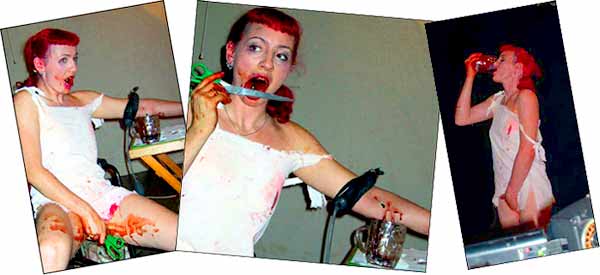
Danielle/BME: You have a world of experience in so many different areas. You are not just a stage performer but also an artist as well. You are in a band, you do photography, and you are naturally a model for your own website and your new project Scarlet Mews. Regarding art and art forms, you recently asked at your online journal, “What is the difference between art, erotica and pornography?” How do you yourself define the differences?
Lucifire: Well, that’s a big ole can of worms. Although there are legal definitions, generally I think it’s quite subjective. British law defines pornography as an erect penis or open vulva. Generally I’d agree with that. I think it also mentions something about “designed specifically to cause sexual arousal”. If there’s more than just that intention then it’s possibly crossing into erotica or art.
For myself I see pornography as being quite obvious, direct and often not very beautiful. My idea of erotica is something less direct where suggestion and sensuality and beauty are the overriding concerns. I would see art as being more concerned with the message or medium rather than arousal. It’s all very muddy and one person’s art may be someone else’s pornography. I think erotica lies somewhere in the middle. I would be happy to show and discuss art or erotica with my parents; I would feel uncomfortable doing the same with pornography.
Danielle/BME: Your current look could be described as both artistic and erotic. You used to have quite a different look from what you have now. What triggered the dramatic transformation to über-femme and how has it changed how your audiences receive you?
Lucifire: I didn’t see my transformation as all that dramatic, it happened over a period of time. When I was younger I was a raging killer feminist. I had a lot to prove about female strength, independence and ability. Tank Girl was my teen idol, along with Ripley from Alien.
Over the years I would sometimes get into fancy dress as a “girl” just for a laugh. I did it more and more and got to like it. I was also getting quite heavily into the swing scene and loved the fashion. I had less to prove about my own strength and found it was even more subversive to look like an “über-femme” but do really hardcore things. It messes with people’s heads but is also more accessible.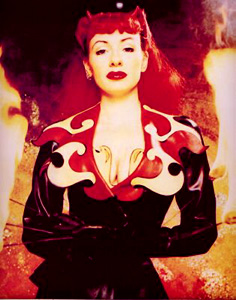
“Straight” audiences will accept you easier if you look sweet n’ pretty but they find it harder to reconcile what you look like with what you do. It’s easy to understand and dismiss a butch girl doing butch or scary stuff; I love confusing them and breaking their preconceptions. If I can make someone question their stereotypes I’ve done a great job.
I looked like a baby Tank Girl for years and years. I had a shaved head with 2 little red horns, wore ripped tight shorts n’ braces, little bra tops and big bike boots. Most of my clothes came from army surplus stores.
Nowadays most of my clothing comes from vintage shops or I make myself from vintage patterns. I have shoulder length hair that is usually set in 40′s styles with rollers. I find it highly amusing that I am so granny-like, stocking up on setting lotion and gin. My hair is still bright fire red though and I still have my piercings. I am not trying to step back in time, just drag the 40′s and 50′s kicking and screaming into my world.
Danielle/BME: You seem to incorporate an element of sexuality into all facets of your art, from your onstage performances to the photographic sessions you in which you are the subject. Why is this?
Lucifire: I am fascinated by sexuality, gender, and what is deemed acceptable or arousing. I admit I’ve traded heavily on sex in my career for a couple of reasons; I am a very sexual person and can’t think of a more exciting and universal subject matter — it is easier to get into people’s heads and have them accept what you are doing if they find you sexually attractive. It messes with their heads when you are both sexy and repulsive at the same time, hence my term “Grotesque Burlesque”.
Sex is a great leveler in life. Almost everyone wants it, although I’ve discovered not many people are obsessed with it as I am. It’s been a big problem in my love life, finding someone or some two/three with an appetite to match mine.
Danielle/BME: Scarlet Mews is a new project of yours. What influenced you to get into producing erotica for the sake of art and erotica (as opposed to being erotic in your performance)?
Lucifire: I think this is just my most recent exploration into sexuality. I’ve reached a point where I feel comfortable in accepting my obsession with sex and have found a way to not only make it a business, but a business that allows me to flex a lot of creative muscles at the same time. Scarlet Mews will not just be a bunch of dirty pictures, but artfully and cleverly designed photo and video shoots as well as short stories and poetry. It encompasses all the arts (except music, at this stage I’ll save that for my band). I’m always looking for new projects; this is my current one.
Danielle/BME: I’m looking forward to seeing it advance. From the photos that are there of you, and those at your personal site one can easily see that you are in phenomenal physical shape; naturally this is necessary for your work. Do you do any special training to stay in top condition?
Lucifire: I go through phases of exercising. I trained as a dancer full time for several years so that got me into good shape then, the constant lugging of heavy cases and bags of kit (steel plates and power tools are pretty heavy you know), over the years I’ve done kickboxing, capoiera, yoga and lots of gym training, even the odd ballet class just to keep myself on top of things. At the moment pretty much all my training is sexcercise, there just aren’t enough hours in the day!
Danielle/BME: I hear that in itself can be phenomenal exercise. I can imagine that some of your stage work requires you to have a calm and clear mind. Do you engage in any form of meditation or centering activities to help you to focus better both in your personal life and in your performances?
Lucifire: The nearest I get to meditation is writing lists, I do that almost religiously and it makes me feel relaxed and that everything is under control.
Danielle/BME: I’m glad to hear I’m not the only one who does that. It definitely helps to ease one’s worries. You’ve done a variety of different acts both on and off the stage; what’s the scariest thing you have done during a performance?
Lucifire: Every new show is terrifying, especially when there are other people in the show and we need to co-ordinate. Every time I try a stunt for the first time it’s scary but that usually passes quickly. Singing on stage the first few times was probably more terrifying for me than any stunt. The thing that still scares me is sticking a needle into my vein in my arm and draining it. It’s the psychological thing of messing with veins that’s scary, I’ve had a bad haematoma from it before and it scared me, thinking I was going to get collapsed veins or something. Stupid I know, junkies do it all the time and they’re not always in top mental form. I think it’s a mental barrier.
Another scary thing is when you come off stage and you have no idea what you just did because you were so transported by the moment, sometimes I can hardly even speak. This is particularly scary when you have injuries and you don’t know how or when. These are special occasions and I treasure them — these are the shows that keep me going, the reason I started and the reason I continue.
Danielle/BME: You must have quite a few stories to tell.
Lucifire: I remember one time being on tour with Killing Joke and suddenly being aware of where I was and what I was doing. I was at an outdoor rock festival in Belgium I think, the sun was shining and it was nearing the end of their set and I’d climbed up the lighting truss at the side of the stage with a mouthful of fuel and a lit torch, I was painted bright blue and wearing just a small loincloth, thirty feet up in the air hanging upside down from just the back of one knee, breathing fire. I was suddenly shocked by the fact I was there and how stupidly dangerous it was… for so many reasons. I loved that tour.
Danielle/BME: That sounds amazing. Though not quite exactly the same there are other artists who do similar work; Steve-O (see our interview with Steve-O from earlier this year), Eric Sprague (The Lizardman), and Tim Cridland (The Torture King) being just a few of those. Are you familiar with them and what do you think of the work that they do?
Lucifire: I’ve never seen any of the above mentioned live but I’ve seen them all on TV and met Lizardman briefly and Tim. I think Tim does amazing stunts. His Sufi training and his dedication has enabled him to do the most incredible piercing shows… not just piercing the skin but right through the middle of limbs.
Danielle/BME: It’s amazing stuff. Considering all you’ve seen and done thus far is there much that you are still curious about that you have seen and want to try?
Lucifire: Bungee jumping, parachuting, having kids, running my new website, bigger shows… everything I haven’t done yet.
Danielle/BME: What performances have you seen that you admire, but that you yourself would be hesitant to do?
Lucifire: Sword swallowing (I tried but didn’t like it, too much gagging), contortion such as Daniel Browning Smith (the Rubber Boy — because he’s an amazing performer, but also I just couldn’t ever physically do what he does), Tom Comet’s shows where he catches a bowling ball on his face, balances a running lawnmower on his upper lip and juggles chainsaws. Tim Cridland’s piercing shows.
Danielle/BME: At the time I sent this interview to you, you hadn’t yet experienced flesh-hook suspension. Now that you have what do you think about it and how has it changed you?
Lucifire: I did a suspension on a day off during the first “modern primitives” tour. John Kamikaze was doing a two-hook suspension every night in the show and was joking around with some of the other guys about them doing it. I wasn’t going to let an opportunity like that go by so I got him to string me up on a day off. It was just for fun, only a couple of friends were there and I used eight hooks instead of two, since I was just a beginner. I stayed up for about half an hour and it was a really amazing experience, feeling the waves of pain wash over me. It doesn’t so much hurt, as throb and pulse in waves. Hard to describe and very intense, not something I’d want to do everyday but I knew I’d definitely do it again.
Danielle/BME: That sounds familiar, most people who do suspensions can’t quite describe the sensations afterwards but they pretty much always want to give it another go. You did another suspension recently — however this time you decided to do it publicly. How was that for you?
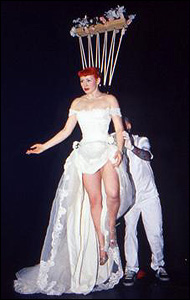 Lucifire: The one I did recently was at the Metal Hammer Awards where I did an upright suspension from six-hooks, once more by Dave Tusk (can you guess yet?). It was all over a bit too quick — I didn’t want to come down. I did a “strung-up pin-up”. I was dressed in a sumptuous sequined burlesque outfit, dripping in diamantes, corseted and wearing glittering high heels. The suspension rig was decked out in white flowers and as the hooks were put in I posed sweetly and sang “I’ve got you under my skin”. The problem I have with a lot of “body art” acts, is that they take too long and lose their impact on the crowd and become self indulgent. It’s hard to find a way of presenting it quickly and powerfully. Allen Falkner of TSD is a master of that but his style is his own and would not work for me so I’m trying to develop this new strung up pin up style.
Lucifire: The one I did recently was at the Metal Hammer Awards where I did an upright suspension from six-hooks, once more by Dave Tusk (can you guess yet?). It was all over a bit too quick — I didn’t want to come down. I did a “strung-up pin-up”. I was dressed in a sumptuous sequined burlesque outfit, dripping in diamantes, corseted and wearing glittering high heels. The suspension rig was decked out in white flowers and as the hooks were put in I posed sweetly and sang “I’ve got you under my skin”. The problem I have with a lot of “body art” acts, is that they take too long and lose their impact on the crowd and become self indulgent. It’s hard to find a way of presenting it quickly and powerfully. Allen Falkner of TSD is a master of that but his style is his own and would not work for me so I’m trying to develop this new strung up pin up style.
Danielle/BME: That sounds amazing — you can definitely put on an eye-catching show. Considering some of the other acts you do on stage I can’t see a flesh suspension as being your most “out there” and controversial act, however Miss Bathory, Rosemary’s Baby, and the Siamese Twins definitely come to mind. What would you consider your most controversial act?
Lucifire: I don’t consider anything I do as being very “out there”, every thing has come into existence through an organic process; it all makes perfect sense to me because I know the background.
Miss Bathory was very disturbing for the audience though. Xena’s (The Warrior Princess) stuntwoman was in the front row and passed out in the first five-minutes — that was a real compliment. A lot of our friends were so disturbed by it they had to leave halfway, and others wanted to “rescue” us. I think that was because, as well as all the blood play, the 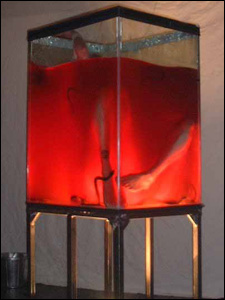 characters were all very disturbed women.
characters were all very disturbed women.
Rosemary’s baby was just a tribute to a film, although quite a gory and fun one.
As for the Siamese twins, I adore them. I love the characters and I love the show. Whenever I see them on video I still laugh out loud. That’s quite something when you created them and know them inside out. The show is so funny that it doesn’t seem harmful to me at all. Although I am not a “born freak” I feel the show was made very sympathetically, and I’ve worked in the Freakshow business for long enough to respect others’ conditions. It was not only a show about freaks and how we perceive them, but a metaphor for living with an incompatible other half, whether that is a sibling, lover, or your own darker side. That’s if you can be bothered to think about it, otherwise it’s just a grotesque comedy.
Then again, masturbating a girl with a pair of scissors on stage until her eyes bleed I guess could be seen as a little “out there”!
Danielle/BME: I could definitely see that as being considered a little bizarre. With all of these acts you play with the very real risk of extreme physical deformity, injury, and death. I assume that you are relatively at peace with the idea of death. Despite that, you must have some tangible fears?
Lucifire: Regrets, finding out that I missed out on something, being old and wishing I had the courage to follow my dreams.
Danielle/BME: I think many people share those fears. Despite how they may look, your performances aren’t about causing you pain — how would you define the acts that you do and why you do them?
Lucifire: I do what I do to entertain and to ask questions. I don’t have all the answers. That’s why I ask them. I want to show people new things and new ways of thinking; I want to point out the wonder of the human body and what it can do, and of course because it gives me a buzz.
Danielle/BME: If you can’t enjoy it there’s no point in doing it. When your performance time is up, do you have a retirement plan or another career you will pursue?
Lucifire: I’ll think of something, and it will be the right thing because it will result out of who I have become. I will not be the same person in ten years time, so how can I decide what that person will do?
Danielle/BME: That’s a good point. I’m sure twenty years ago you didn’t see yourself where you are now. Eventually, as morbid as this is, you will die — do you have any special requests for when that happens?
Lucifire: When I die I want to be cremated and have my ashes put into a firework so I can be exploded over the sky. I think that would be very in keeping with my life and everyone close to me adores fireworks and explosives, I think it would be a fitting end.
Danielle/BME: What do you want people to say about you when you die?
Lucifire: That I had a good life and I was a good person.
Danielle/BME: I can’t see them saying otherwise. You have been great to get to know and I definitely wish you the best in your future endeavors. Thank you so much for taking the time to complete this interview with me. For the reading audience as a recap, what types of events do you entertain at and how can an interested person book you for an event or get ahold of you?
Lucifire: I do a lot of shows at fetish events, gay clubs, artsy or alternative cabarets, tattoo conventions and private parties. Anyone interested in booking me can contact me at [email protected].

Note that Lucifire does not limit herself to the UK or Scotland, she has performed all around the world. Find out more about her at her personal website Lucifire.com, her online livejournal, or her newest site Scarlet Mews.
|
Luci was interviewed by Danielle Clark (iam:Vanilla) through a series of e-mail correspondence. All photos are copyright protected and owned by Lucifire.
|
 |
Copyright © 2003 Danielle Clark and BMEzine.com LLC. Requests to republish must be confirmed in writing. For bibliographical purposes this article was first published online August 20th, 2003 by BMEzine.com LLC in Tweed, Ontario, Canada.






























































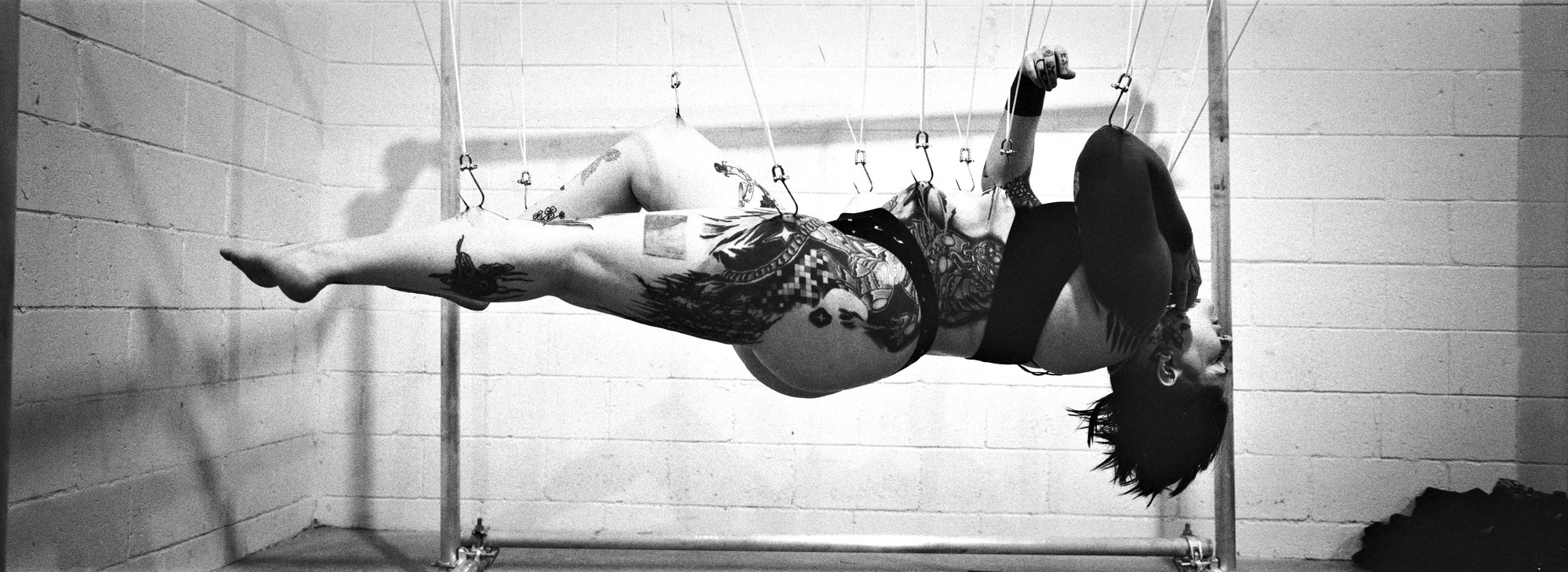




 Lucifire: I grew up in the middle of Scotland, out in the sticks. We moved around a fair bit when I was a kid, we lived in Dundee, then in an artist’s commune in a fishing village on the west coast of Scotland, then a few other places before settling in Carron Valley. It was seven miles to the nearest bus stop and my next-door neighbour on one side was a half a mile away. I guess I had too much time to myself. I didn’t mix much with kids my own age because there weren’t many around. I spent a lot of time in the company of adults and animals. My parents were both very artistic and well educated and encouraged me to be creative and freethinking. I was always the quiet one at the back of the class with my nose buried in a book, a shy retiring wallflower that drew weird pictures and wrote strange stories.
Lucifire: I grew up in the middle of Scotland, out in the sticks. We moved around a fair bit when I was a kid, we lived in Dundee, then in an artist’s commune in a fishing village on the west coast of Scotland, then a few other places before settling in Carron Valley. It was seven miles to the nearest bus stop and my next-door neighbour on one side was a half a mile away. I guess I had too much time to myself. I didn’t mix much with kids my own age because there weren’t many around. I spent a lot of time in the company of adults and animals. My parents were both very artistic and well educated and encouraged me to be creative and freethinking. I was always the quiet one at the back of the class with my nose buried in a book, a shy retiring wallflower that drew weird pictures and wrote strange stories. 

 Lucifire: The one I did recently was at the Metal Hammer Awards where I did an upright suspension from six-hooks, once more by Dave Tusk (can you guess yet?). It was all over a bit too quick — I didn’t want to come down. I did a “strung-up pin-up”. I was dressed in a sumptuous sequined burlesque outfit, dripping in diamantes, corseted and wearing glittering high heels. The suspension rig was decked out in white flowers and as the hooks were put in I posed sweetly and sang “I’ve got you under my skin”. The problem I have with a lot of “body art” acts, is that they take too long and lose their impact on the crowd and become self indulgent. It’s hard to find a way of presenting it quickly and powerfully. Allen Falkner of TSD is a master of that but his style is his own and would not work for me so I’m trying to develop this new strung up pin up style.
Lucifire: The one I did recently was at the Metal Hammer Awards where I did an upright suspension from six-hooks, once more by Dave Tusk (can you guess yet?). It was all over a bit too quick — I didn’t want to come down. I did a “strung-up pin-up”. I was dressed in a sumptuous sequined burlesque outfit, dripping in diamantes, corseted and wearing glittering high heels. The suspension rig was decked out in white flowers and as the hooks were put in I posed sweetly and sang “I’ve got you under my skin”. The problem I have with a lot of “body art” acts, is that they take too long and lose their impact on the crowd and become self indulgent. It’s hard to find a way of presenting it quickly and powerfully. Allen Falkner of TSD is a master of that but his style is his own and would not work for me so I’m trying to develop this new strung up pin up style.  characters were all very disturbed women.
characters were all very disturbed women. 

